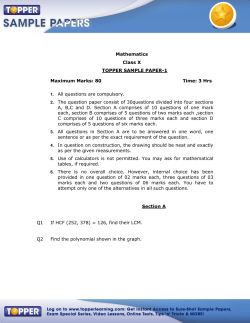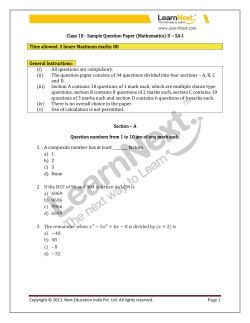
Time: 3 to 3 ½ hours M.M.:90
Sample Question Paper Mathematics First Term (SA - I) Class IX Time: 3 to 3 ½ hours M.M.:90 General Instructions (i) All questions are compulsory. (ii) The question paper consists of 34 questions divided into four sections A, B, C and D. Section A comprises of 8 questions of 1 mark each, section B comprises of 6 questions of 2 marks each, section C comprises of 10 questions of 3 marks each and section D comprises of 10 questions of 4 marks each. (iii) Question numbers 1 to 8 in section A are multiple choice questions where you have to select one correct option out of the given four. (iv) There is no overall choice. However, internal choice has been provided in 1 question of two marks, 3 questions of three marks each and 2 questions of four marks each. You have to attempt only one of the alternatives in all such questions. SECTION A Question numbers 1 to 8 carry 1 mark each. For each question, four alternative choices have been provided of which only one is correct. You have to select the correct choice Q .1 Solution Ans : [A] Q .2 Which of the following expressions is a polynomial? Ans: [C] Q .3 If a + b + c = 0, then (A) 0 Solution Ans: [D] (B) abc (C) 2abc (D) 3abc Q .4. The maximum number of terms in a polynomial of degree 10 is : (A) 9 (B) 10 Solution Ans: [C] Q .5 In the given figure, if Solution: (C) 11 (D) 1 Q .6 Solution The two triangles will be congruent by SAS axiom if AC = DE Ans : [D] Q. 7 Area of an equilateral triangle of side ‘a ’ units can be calculated by using the formula : Solution Side of an equilateral triangle = a units Ans : [D] Q. 8 The area of in which AB = BC = 4 cm and Solution Ans : [B] SECTION – B Question numbers 9 to 14 carry two marks each Q. 9 Solution Q. 10 Find the value of k, if Solution: Q. 11 Solution: Q. 12 In the given figure, a and b Solution , then find the value of Q. 13 In the given figure, and OR In the figure given below AC > AB and AD is the bisector of Solution In the given figure, OR Q. 14 Plot the point which lies on y axis and at a distance of 4 units in the negative direction of y axis. Also find its coordinates Solution The coordinates of the point are SECTION – C Question numbers 15 to 24 carry three marks each Q. 15 Prove that Solution Q. 16 OR Visualise 3.765 on the number line, using successive magnification Solution OR Q. 17 OR What are the possible expressions for the dimensions of a cuboid whose volume is given below? Solution OR Factorising the expression given for volume, we get Q. 18 Solution Q. 19 OR In the given figure, bisectors of at P and Q respectively. Prove: Solution OR In parallelogram ABCD Q. 20 In the given figure, Find the value of x Solution Q. 21 In the given figure, AB = AC, D is the point in the interior of Prove that AD bisects . Solution Q. 22 In the given figure, AB = BC and AE = CD Prove that BD = BE Solution Q. 23 In the given figure, if Solution Q. 24 The perimeter of a triangular field is 300 cm and its sides are in the ratio 5 : 12 : 13. Find the length of the perpendicular from the opposite vertex to the side whose length is 130 cm Solution: Ratio of the sides of the triangular field = 5 : 12 : 13 Let the sides be 5x cm, 12x cm and 13x cm Perimeter of the triangular field = 300 cm Let AD be the perpendicular from the opposite vertex to the side of length 130 cm SECTION – D Question numbers 25 to 34 carry four marks each. Q. 25 Rationalise the denominator of OR Solution OR (Student can use any one of the following methods) Method 1: Method 2: Q. 26 Solution Q. 27 Verify that Solution Q. 28 If the values of m and n. Solution as a factor, and leaves a remainder n when divided by find Q. 29 (i) Expand: (ii) Evaluate by using suitable identity OR Factorise : Solution OR Q. 30 Prove that the sum of all sides of a quadrilateral is greater than the sum of its diagonals Solution: Given : A quadrilateral ABCD with diagonals AC and BD To prove : AB + BC + CD + DA > AC + BD Proof : In a triangle sum of any two sides is greater than the third side Q. 31 Plot the following points and check whether they are collinear or not : (1, 1) (2, − 3) (−1, −2) Solution: Given points do not lie on a single straight line. Hence, they are not collinear. Q. 32 ABC is a triangle with Prove that Solution: is a point on BC such that AD bisects Q. 33 In the given figure, if AD is the bisector of (i) AB > BD (ii) AC > CD Solution: then prove that : Q. 34 BE and CF are two equal altitudes of a triangle ABC. Prove that the triangle ABC is isosceles Solution
© Copyright 2025





















